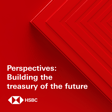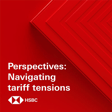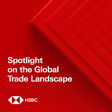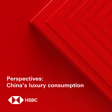Become a Creator today!Start creating today - Share your story with the world!
Start for free
00:00:00
00:00:01

Under the Banyan Tree - The economics of going green in Asia
Herald van der Linde is joined by Evan Li, Head of Asia Energy Transition Research, to discuss the opportunities and challenges of renewable energy in the region, where China is both the leading polluter and number one name in solar and wind.
Disclaimer: https://www.research.hsbc.com/R/51/FjWqvLS Stay connected and access free to view reports and videos from HSBC Global Research follow us on LinkedIn https://www.linkedin.com/feed/hashtag/hsbcresearch/ or click here: https://www.gbm.hsbc.com/insights/global-research.
Hosted on Acast. See acast.com/privacy for more information.
Transcript
Podcast Introduction and Series Overview
00:00:00
Speaker
Welcome to HSBC Global Viewpoint, the podcast series that brings together business leaders and industry experts to explore the latest global insights, trends, and opportunities.
00:00:11
Speaker
Make sure you're subscribed to stay up to date with new episodes.
00:00:14
Speaker
Thanks for listening.
00:00:15
Speaker
And now onto today's show.
00:00:16
Speaker
This is a podcast from HSBC Global Research, available on Apple Podcasts and Spotify.
00:00:22
Speaker
Search for HSBC Global Viewpoint or join us via the HSBC Global Banking and Markets page on LinkedIn.
00:00:29
Speaker
However you're listening, analyst notifications, disclosures and disclaimers must be viewed on the link attached to your media player.
Focus on Asia in Global Energy Transition
00:00:45
Speaker
Hello from Hong Kong and welcome to Under the Banyan Tree, where we put Asian markets and economics in context.
00:00:51
Speaker
I'm Harold van der Linde, HSBC's Asian Equity Strategist, and on today's podcast we're going to bring you up to speed on Asia's role in the global renewable story.
00:01:01
Speaker
It's a pertinent time to talk about this, with the ongoing energy crisis, lots of regulatory changes, inflationary pressures, they're all big themes as we kick off 2023.
China's Role in Renewable Energy
00:01:10
Speaker
Not to mention mainland China's effort to cut back on coal, the most carbon-intensive power source on the whole planet.
00:01:18
Speaker
Joining me to help make sense of it all is Head of Asia Energy Transition Research, Evan Lee.
00:01:24
Speaker
Let's kick off the conversation right here, under the banyan tree.
00:01:33
Speaker
Let me first set the scene before we start.
00:01:35
Speaker
In previous podcasts we've spoken about energy transition and there's a couple of kind of long-term issues at play across the region.
00:01:42
Speaker
I would say first of all there is an increased focus on self-sufficiency in energy in general that is driven very often by geopolitical considerations.
00:01:53
Speaker
Of course there are climate considerations.
00:01:55
Speaker
We don't want industries that pollute so much anymore.
00:01:59
Speaker
And of course, then there are other issues such as, for example, the energy crisis that we see in
Market Performance and Carbon Neutrality Goals
00:02:04
Speaker
Europe.
00:02:04
Speaker
Now, meanwhile, Asia is home to two of the world's three highest producers of carbon dioxide emissions.
00:02:11
Speaker
China takes the top spot with more than 30%, followed by the US in second and India in third.
00:02:17
Speaker
And that sparked billions of dollars in investments in green energy across the region in recent years.
00:02:23
Speaker
But 2022 was a rough year, where the wind and solar names covered by AGBC underperformed the market by 53% and 24% respectively.
00:02:32
Speaker
To put that in context, the Hang Seng Index here in Hong Kong was down around 15% over the same period.
00:02:38
Speaker
Evan Lee joins me now here to discuss the outlook for Asian renewables in 2023, but also beyond.
00:02:45
Speaker
Evan, welcome to the podcast.
00:02:47
Speaker
Thank you, Harold, for having me.
00:02:49
Speaker
Let's focus on China first.
00:02:52
Speaker
What are China's stated goals over the next decade when it comes to energy transition?
00:02:57
Speaker
Yeah, so let's dial back two, three years ago, back in 2020, around September.
00:03:03
Speaker
China obviously has announced its first climate mandate, that is to peak its carbon emission by 2030, and also try to go for carbon neutrality by 2060.
00:03:15
Speaker
When we say carbon neutrality, essentially that means reducing carbon dioxide emission or greenhouse gas emission
00:03:23
Speaker
by switching energy from fossil fuel to renewables such as solar and wind or another way to do it is to either capture the carbon that goes out into the atmosphere or essentially plant more trees as a way to absorb carbon into the system.
00:03:43
Speaker
So the net is zero in a sense.
00:03:44
Speaker
Exactly.
00:03:45
Speaker
So basically, the goal for China is basically go for net zero emission on greenhouse
Challenges in China's Energy Strategy
00:03:51
Speaker
gas.
00:03:51
Speaker
So that's the long term story.
00:03:53
Speaker
But what is then the story in 2023?
00:03:54
Speaker
What's happening in 2023 in order for them to get there, in a sense?
00:03:59
Speaker
Yeah, so we do still believe that the climate goals remain unchanged.
00:04:03
Speaker
Just bear in mind that China has obviously announced a lot of policies to push for, and again, net zero since 2020.
00:04:12
Speaker
So we have gone through a big ride of policy push, government support, subsidies, repricing of energy.
00:04:21
Speaker
But one thing that we have to also understand is that is over the last year or so,
00:04:26
Speaker
Energy demand has been adjusted down because of a lot of other economic concerns.
00:04:31
Speaker
China obviously has gone through COVID.
00:04:33
Speaker
Just remember that.
00:04:34
Speaker
You mean there's less demand?
00:04:36
Speaker
Yes.
00:04:36
Speaker
Yes.
00:04:37
Speaker
And obviously with less demand on energy, the expectation on managing its curve to achieve carbon peaking has sort of been reshuffled in a way.
00:04:49
Speaker
And in fact, because the companies that are producing the equipment along the value chain of both wind and solar has faced certain bottlenecks, we do believe that China hasn't really been able to deliver the capacity or the insulation of wind and solar as it should in order to achieve the climate curve.
00:05:08
Speaker
But however, that is not very important because demand has also shrunk.
00:05:13
Speaker
Mm-hmm.
00:05:14
Speaker
So let's unpack this a little bit.
00:05:15
Speaker
So, yeah, the world has changed and people need to recalibrate their plans.
00:05:19
Speaker
So let's just look at the different industries here.
Solar Industry Dynamics in China
00:05:22
Speaker
First, the solar industry in China.
00:05:25
Speaker
What is the solar industry?
00:05:26
Speaker
Of course, it's panels.
00:05:27
Speaker
But how does that industry actually look like?
00:05:30
Speaker
What are the components of that industry?
00:05:33
Speaker
So most people would look at solar as like a solar module system that they put on top of the roof or in an industrial park or something like that.
00:05:43
Speaker
But the supply chain is quite complicated.
00:05:45
Speaker
So we will start from polysilicon at the very upstream.
00:05:48
Speaker
That is the raw material that they create out of sand that will be used to make something called wafers and turn into solar cells.
00:05:57
Speaker
With the solar cells, they would pack it together and they would add a sheet of solar glass right on top as a protection layer to form a solar module that eventually gets installed into a solar system that will be used by either commercial or consumer end users or even by the power utility companies that lay it out onto the ground to produce electricity.
00:06:19
Speaker
Yeah.
00:06:20
Speaker
So, OK, so those are the different components of the industries.
00:06:23
Speaker
In 2023, within solar in China, where are the bright spots and where are the challenges in that supply chain?
00:06:31
Speaker
So this becomes a little more tricky because the demand supply across the different subsets are not very even.
00:06:37
Speaker
In the past two years, we're faced with very tight supply of polysilicon.
00:06:42
Speaker
It takes about two years to create.
00:06:45
Speaker
So when China and every wells in the world is trying to lift their climate targets, creating strong need for solar, the supply in polysilicon had been very tight.
00:06:55
Speaker
from the last two to three years.
00:06:57
Speaker
But that issue is sort of resolved with China being very dominant in supply for polysilicon, which has obviously created a lot of new capacity over the last six to 12 months.
00:07:09
Speaker
So the prices will go down, I suspect.
00:07:11
Speaker
And in fact, prices have collapsed over the last few weeks in anticipation of new supply.
00:07:17
Speaker
So now the rest of the supply chain would actually benefit on a lower cost.
00:07:21
Speaker
And with the lower pricing on these solar modules, we do believe that demand will be created as well.
00:07:26
Speaker
That's good news, I guess, for the glassmakers as well, or it doesn't matter too much?
00:07:30
Speaker
Glassmakers will benefit, obviously, because they're a natural beneficiary when demand goes up.
00:07:35
Speaker
And especially for China that owns almost 90% of solar glass supply of the world, when demand goes up on lower costs of polysilicon from the upstream,
00:07:47
Speaker
solar glass would naturally benefit.
00:07:49
Speaker
Yeah, because people will buy more of these modules.
00:07:52
Speaker
Okay, so we know where the bright spots and the challenges are in solar and to keeping basically supply and demand across that food chain in Czech is a challenge.
Wind and Other Energy Sources in China
00:08:01
Speaker
Is that the same case in the wind industry in China as well?
00:08:05
Speaker
Wind is a little bit different.
00:08:06
Speaker
When we look at solar, we have to understand global demand and global supply, given China is very dominant across the chain.
00:08:14
Speaker
But when it comes to wind, it's going to be very domestic because whatever that's being produced in China mainly gets sold back to China.
00:08:23
Speaker
Export is not a very big story for the Chinese producers when it comes to wind equipment.
00:08:29
Speaker
That's really domestic markets.
00:08:32
Speaker
So Evan, we looked at solar, we looked at wind.
00:08:34
Speaker
There are some challenges here and there.
00:08:36
Speaker
What are some of the other industries that we should be looking at when it comes to energy transition in China?
00:08:42
Speaker
For sake of sufficient energy supply, China will invest further in coal and nuclear, mainly because renewable energy overall is still a small fraction of total electricity and energy supply for the country.
00:08:56
Speaker
How much is it, by the way, at the moment?
00:08:58
Speaker
Wind and solar alone combined is only about 12% of electricity supply in China, which is still quite small.
00:09:06
Speaker
So China itself is still very reliant on coal, which is fossil fuel.
00:09:12
Speaker
Because they still need energy.
00:09:13
Speaker
Exactly.
00:09:15
Speaker
Now, we now understand the challenges and sort of the bright spots in China a little bit and also what their policies
India's Climate Initiatives and Challenges
00:09:21
Speaker
are.
00:09:21
Speaker
I think in a second we're going to talk about what is happening in the rest of the region.
00:09:34
Speaker
So we're back again, Evan.
00:09:36
Speaker
We've spoken about China.
00:09:37
Speaker
We've seen that China has got some pretty ambitious goals, but that the supply and demand issues across these food chains is really making it difficult for these industries to meet those goals in the next couple of years or so.
00:09:51
Speaker
But let's now look at the rest of Asia.
00:09:54
Speaker
I think all countries in Asia have some renewable energy policy in place, but the big one I presume is India, right?
00:10:01
Speaker
And what is happening in India?
00:10:04
Speaker
India has definitely put out some very ambitious goals when it comes to climate, including net zero targets and policy support coming from incentives and government subsidies.
00:10:17
Speaker
I guess we have to look at it from a few ways.
00:10:20
Speaker
So first of all, many major markets are trying to set up their own value chain in solar, but China is already very dominant, very cost-efficient in producing solar equipments and solar modules.
00:10:31
Speaker
So without meaningful government incentives for the producers to set up their own factories in producing polysilicon solar cells and solar modules,
00:10:43
Speaker
We think it's going to be quite challenging for India to be a supplier of solar equipments.
00:10:49
Speaker
But when it comes to transitioning energy supply into renewables, India could be a big buyer of these solar components from producers like China.
00:11:01
Speaker
So the Indians have to buy solar equipment from the Chinese.
00:11:04
Speaker
And that goes against, I guess, the self-sufficiency that they're trying to look for.
00:11:09
Speaker
Is that correct?
00:11:10
Speaker
Potentially could be, but we'll have to see what kind of government subsidies that will be provided.
00:11:16
Speaker
What about wind?
00:11:16
Speaker
Are they big in wind as well?
00:11:18
Speaker
India has its own supply chain in wind.
00:11:21
Speaker
In fact, India has been quite good in producing wind turbines.
00:11:25
Speaker
And just like many other countries, as I've sort of mentioned, wind is actually quite domestic.
00:11:30
Speaker
We think India is actually quite self-sufficient.
00:11:33
Speaker
Okay.
00:11:33
Speaker
And I guess that helps them because, as you mentioned, on the solar side, they struggle because they will need to buy from China if they want to be competitive.
00:11:43
Speaker
Are there any other initiatives that India is putting in place as well?
00:11:46
Speaker
Are they big in nuclear or anything else?
Asian Reliance on Chinese Energy Components
00:11:51
Speaker
Nuclear is a part and there are other smaller types of renewable components.
00:11:56
Speaker
But overall, wind and solar combined is still quite a small mix.
00:12:00
Speaker
So India as a whole still has to import a lot of oil and gas.
00:12:04
Speaker
Okay.
00:12:05
Speaker
And is that the same story for the rest of Asia as well?
00:12:08
Speaker
Other countries in Asia?
00:12:09
Speaker
That's quite similar, I would say.
00:12:11
Speaker
Particularly in solar, the rest of the Asian countries are still going to be very reliant on Chinese supply of solar components.
00:12:21
Speaker
And for wind, they can get that from India or elsewhere?
00:12:24
Speaker
Wind, they will get it from India.
00:12:26
Speaker
China obviously is a big supplier of that.
00:12:29
Speaker
There are other international players that are providing equipment into the region.
00:12:33
Speaker
Many of the ASEAN, Southeast Asian countries are a big fan of these international brand names, which they would obviously cost more to buy, but there's a market there.
00:12:45
Speaker
Okay, well, we've spoken about renewables in the Asian region.
00:12:49
Speaker
Asia has some ambitious goals when it comes to energy transition.
00:12:53
Speaker
Renewables are growing, but it's still a small part or not a dominant part of overall energy supply yet.
00:13:00
Speaker
So Asia will continue to buy oil, gas and coal.
00:13:04
Speaker
What we then see is that in particular industries, there are all sorts of supply and demand micro issues at play, in particular, I would say in solar, but in wind as well.
00:13:13
Speaker
And because China is so dominant in solar, it actually means that all the other countries still rely on China for that particular supply of solar panels or glass or polysilicon.
00:13:23
Speaker
So it's a very complex story, this energy transition, and I suspect we're going to revisit this regularly under the banyan tree.
00:13:30
Speaker
Thank you, Evan.
00:13:31
Speaker
Thank you, Harold.
00:13:33
Speaker
And that's a wrap for this edition of Under the Banyan Tree.
00:13:36
Speaker
Thanks, as always, for joining us.
00:13:37
Speaker
We're going to take a break over the Chinese New Year.
00:13:39
Speaker
That's next week.
00:13:40
Speaker
But we'll be back the following week putting Asian markets and economics in context.
00:13:45
Speaker
Take care.
00:13:46
Speaker
Till then.
00:13:47
Speaker
Thank you for joining us at HSBC Global Viewpoint.
00:13:50
Speaker
We hope you enjoyed the discussion.
00:13:52
Speaker
Make sure you're subscribed to stay up to date with new episodes.

















